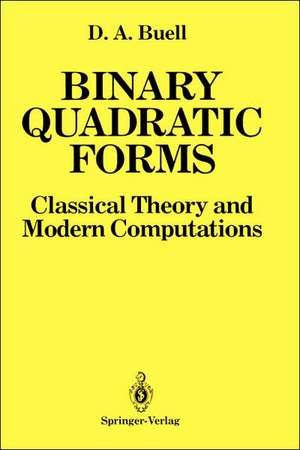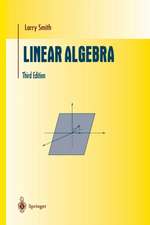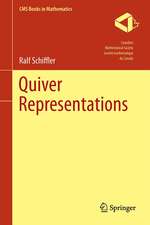Binary Quadratic Forms: Classical Theory and Modern Computations
Autor Duncan A. Buellen Limba Engleză Hardback – 25 aug 1989
| Toate formatele și edițiile | Preț | Express |
|---|---|---|
| Paperback (1) | 943.92 lei 43-57 zile | |
| Springer – 26 sep 2011 | 943.92 lei 43-57 zile | |
| Hardback (1) | 972.09 lei 43-57 zile | |
| Springer – 25 aug 1989 | 972.09 lei 43-57 zile |
Preț: 972.09 lei
Preț vechi: 1185.47 lei
-18% Nou
Puncte Express: 1458
Preț estimativ în valută:
186.07€ • 202.18$ • 156.40£
186.07€ • 202.18$ • 156.40£
Carte tipărită la comandă
Livrare economică 21 aprilie-05 mai
Preluare comenzi: 021 569.72.76
Specificații
ISBN-13: 9780387970370
ISBN-10: 0387970371
Pagini: 248
Ilustrații: X, 248 p.
Dimensiuni: 155 x 235 x 18 mm
Greutate: 1.21 kg
Ediția:1989
Editura: Springer
Colecția Springer
Locul publicării:New York, NY, United States
ISBN-10: 0387970371
Pagini: 248
Ilustrații: X, 248 p.
Dimensiuni: 155 x 235 x 18 mm
Greutate: 1.21 kg
Ediția:1989
Editura: Springer
Colecția Springer
Locul publicării:New York, NY, United States
Public țintă
ResearchDescriere
The first coherent exposition of the theory of binary quadratic forms was given by Gauss in the Disqnisitiones Arithmeticae. During the nine teenth century, as the theory of ideals and the rudiments of algebraic number theory were developed, it became clear that this theory of bi nary quadratic forms, so elementary and computationally explicit, was indeed just a special case of a much more elega,nt and abstract theory which, unfortunately, is not computationally explicit. In recent years the original theory has been laid aside. Gauss's proofs, which involved brute force computations that can be done in what is essentially a two dimensional vector space, have been dropped in favor of n-dimensional arguments which prove the general theorems of algebraic number the ory. In consequence, this elegant, yet pleasantly simple, theory has been neglected even as some of its results have become extremely useful in certain computations. I find this neglect unfortunate, because binary quadratic forms have two distinct attractions. First, the subject involves explicit computa tion and many of the computer programs can be quite simple. The use of computers in experimenting with examples is both meaningful and enjoyable; one can actually discover interesting results by com puting examples, noticing patterns in the "data," and then proving that the patterns result from the conclusion of some provable theorem.
Cuprins
1 Elementary Concepts.- 2 Reduction of Positive Definite Forms.- 3 Indefinite Forms.- 3.1 Reduction, Cycles.- 3.2 Automorphs, Pell’s Equation.- 3.3 Continued Fractions and Indefinite Forms.- 4 The Class Group.- 4.1 Representation and Genera.- 4.2 Composition Algorithms.- 4.3 Generic Characters Revisited.- 4.4 Representation of Integers.- 5 Miscellaneous Facts.- 5.1 Class Number Computations.- 5.2 Extreme Cases and Asymptotic Results.- 6 Quadratic Number Fields.- 6.1 Basic Algebraic Definitions.- 6.2 Algebraic Numbers and Quadratic Fields.- 6.3 Ideals in Quadratic Fields.- 6.4 Binary Quadratic Forms and Classes of Ideals.- 6.5 History.- 7 Composition of Forms.- 7.1 Nonfundamental Discriminants.- 7.2 The General Problem of Composition.- 7.3 Composition in Different Orders.- 8 Miscellaneous Facts II.- 8.1 The Cohen-Lenstra Heuristics.- 8.2 Decomposing Class Groups.- 8.3 Specifying Subgroups of Class Groups.- 8.3.1 Congruence Conditions.- 8.3.2 Exact and Exotic Groups.- 9 The 2-Sylow Subgroup.- 9.1 Classical Results on the Pell Equation.- 9.2 Modern Results.- 9.3 Reciprocity Laws.- 9.4 Special References for Chapter 9.- 10 Factoring with Binary Quadratic Forms.- 10.1 Classical Methods.- 10.2 SQUFOF.- 10.3 CLASNO.- 10.4 SPAR.- 10.4.1 Pollard p — 1.- 10.4.2 SPAR.- 10.5 CFRAC.- 10.6 A General Analysis.- Appendix 1:Tables, Negative Discriminants.- Appendix 2:Tables, Positive Discriminants.









